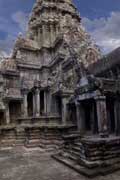 |
| 1. Angkor Wat
|
|
 |
 |
| 2. Decorative carvings
|
|
 |
 |
| 3. The central tower
|
|
 |
 |
| 4. Steep stairs
|
|
|
 |
|
 |
"The Governor of Siamrap having provided us with three elephants, ... we passed quickly and silently along a narrow but good road cut through the dense, riant forest, until, on suddenly emerging from the woods, we saw a little way off to the right, across a pond filled with lotus plants, a long row of columned galleries, and ... three or four immense pagodas, built of a dark-grey stone. And my heart almost bounded into my mouth as the Cambodian driver said — Angkor Wat."
— Frank Vincent, Jr., 1872
Angkor Wat is difficult to describe. It is huge, the largest temple in the Angkor group; it is the most intact of the temples, and it is an artistic and architectural masterpiece. It is the best of the Khmer monuments in every way. Its composition, balance, proportion, and decoration (photo #2) make it one of the greatest masterpieces of all places and all times. It is certainly awe inspiring, even when it is teeming with tourists from all over the world. In some ways, this mass of tourists may be appropriate to our experience of Angkor Wat. The temple would certainly have teemed with people during the years when it was the Khmer center for the worship of the Hindu god Vishnu.
Angkor Wat occupies an area of 500 acres surrounded by a laterite wall 3.5 miles long. The wall is surrounded by a moat over 600 feet wide. The causeway which crosses the moat is 40 feet wide and over 800 feet long. Once inside the wall, you walk on a raised platform over 1,100 feet long to reach the temple. The temple building itself is on three levels. The first level is a series of galleries of bas-reliefs which completely surround the temple. The gallery on each side is 700 feet long. The second level galleries are over 300 feet on a side, with a tower on each corner. The third level galleries are 200 feet on each side. The 3rd level also contains the five great towers of Angkor Wat. The central sanctuary (photo #3) is the largest tower of them all, standing 140 feet above its base (and 213 feet above the ground). By any measure, Angkor Wat is tremendous; it is reputed to be the largest religious monument ever constructed.
It would take days to explore the temple completely; we spent two afternoons here, and did not begin to see it all. One of the best ways to get a feel for the layout of the temple is to view the scale model sculpted by Dy Proeung in Siam Reap.
Access to the temple is by a series of increasingly difficult stairs. The final ascent to the third level requires a climb of 43 feet on 40 very narrow steps, which results in a stairway angle of 70 degrees. As with the other temples we visited, the stone steps have deteriorated over time, and the climb feels quite precarious. One of the twelve stairways has been equipped with a small steel handrail. Climbing up without the handrail was not too bad. However, there was often a long line, and as much as a 20-minute wait, to use the handrail for the more frightening trip back down (photo #4).
Here are thirteen more photos of Angkor Wat:
"... one need never say good-bye to Angkor, for its magic will go with you wherever fate and the gods may take you to colour your thoughts and dreams to life's very end."
— H. W. Ponder, 1936
— return to the top of the page
— return to the 2004 Journal Archive
|